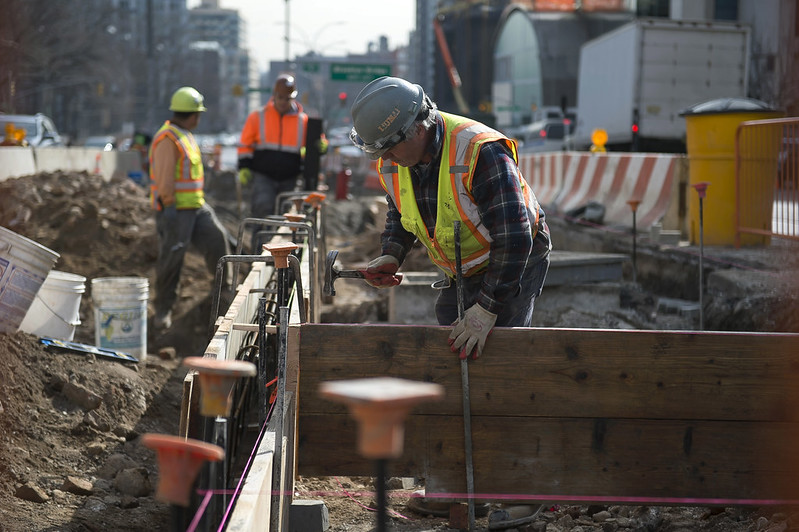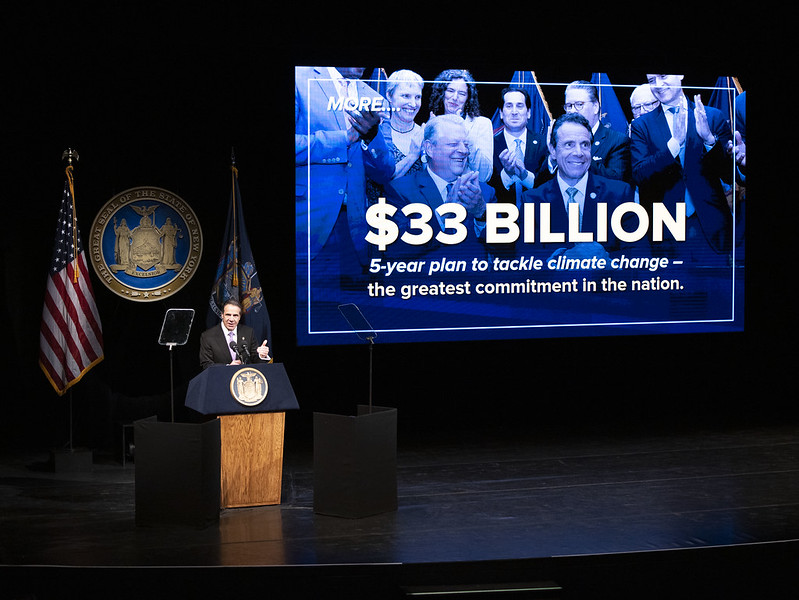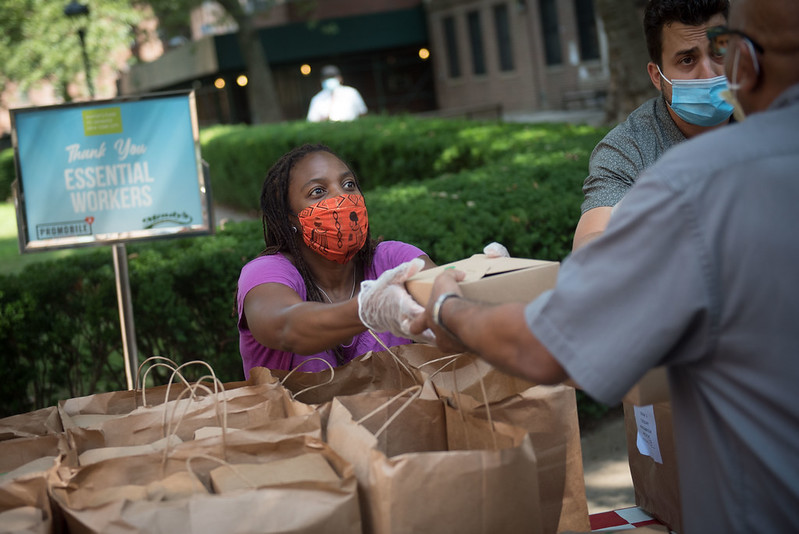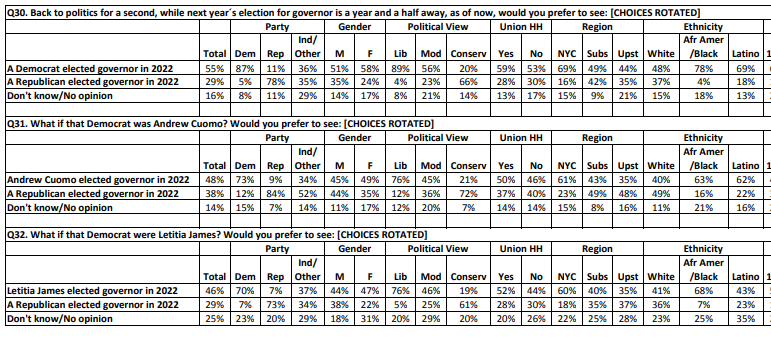Letter to the Editor: How to Really Prepare Workers for the Construction Industry and Good Middle-Class Jobs

Workers rebuilding New York (photo: Ed Reed/Mayoral Photography Office)
To The Editor:
A recent op-ed published at Gotham Gazette, co-authored by David Meade, executive director of Building Skills New York, was riddled with classic smoke and mirrors. One might be tempted to believe that Building Skills offers a chance to build public infrastructure with skilled training, safe career pathways, and incredible pay and benefits. Unfortunately, that’s far from the truth. In reality, Building Skills is a developer-backed organization churning out cheap labor for New York City’s multi-million-dollar private developers, even if it means putting those workers in danger with less training and unsafe job sites.
There is of course a need for skills-training and helping ensure that New Yorkers are ready for available jobs in the construction industry. But the details really matter. The apprenticeship programs of the New York City District Council of Carpenters (NYCDCC) Training Center are all registered with the New York State Department of Labor. A carpenter trained at our Training Center earns union wages and benefits that increase regularly. Meanwhile, our internal investigations show that Building Skills graduates struggle to earn little more than minimum wage.
Low-wage workers are also more likely to be the victims of wage theft, which is why the District Council made it our mission to work with State Senator Jessica Ramos and Assemblymember Latoya Joyner to pass legislation in Albany to protect vulnerable construction workers like graduates of Building Skills. If Building Skills is really meant to provide opportunities for women and communities of color, then why on Earth are they sending graduates to job sites where they will get less pay and barely any benefits, and where they are more likely to be put in danger? It’s predatory.
Building Skills also claims that their trainees will work on public infrastructure, but the developers they are associated with rarely build roads, bridges, or mass transit. Why? Well, because federal law stipulates that on those projects, workers must be paid a prevailing wage, which the developers associated with Building Skills almost always refuse to do. That is why union carpenters and contractors have been busy fixing highways across Long Island, expanding airports like JFK and LaGuardia, building schools, and fixing roads—public necessities that all our communities rely on. In addition, Building Skills does not provide the relevant experience and training required for their graduates to work on these massive and complicated projects.
The only thing Mr. Meade is correct about is that the construction industry needs to continue to aggressively provide opportunities for underrepresented communities.
In addition to the NYCDCC Training Center, there are other successful, nationally recognized programs that provide training and a pipeline to help women, minorities, and veterans such as Building Works, Construction Skills, NEW, and Helmets to Hardhats. Take one tour of the NYCDCC’s world-class Training Center or visit any of our job sites to see that the 21st century union carpenters not only look like America, but unlike a Building Skills graduate, are paid a middle-class wage with benefits, job protections, and retirement security.
Every worker in New York City deserves the same pay, benefits, and retirement security that the NYC District Council of Carpenters offers. We urge elected officials in all five boroughs to work with the NYCDCC to give workers what they deserve.
Sincerely,
Joseph Geiger
Executive Secretary-Treasurer of the NYCDCC
On Twitter @395Hudson & @CarpentersNYC
***
Have an op-ed idea or submission for Gotham Gazette? Email This email address is being protected from spambots. You need JavaScript enabled to view it.
The Massive Budget Power of the New York Governor and What’s at Stake in 2022

Gov. Cuomo presenting a budget (photo: Mike Groll/Office of Governor Andrew M. Cuomo)
Governor Andrew Cuomo will soon be in the rearview mirror for New Yorkers as a result of his announced resignation on August 10, 2021, effective 14 days later. A fresh start will be a welcome relief for all New Yorkers. That is because, as we face 2022, everyone who seeks a government that strives for justice must take heed that the office of the Governor of New York is the most powerful public office in the state, and then some.
In the decade-long budget battles between former Governor George Pataki and the Democratic-controlled State Assembly in the ‘90s and early 2000s, the state’s highest court sided with the Governor in a decision that gave unparalleled leverage to the executive in budget negotiations. If a hard-right conservative wins the Governor’s office in next year’s election, that awesome executive budget power could put the brakes on and roll back New York’s broad movement toward equity in health care, public education, human services, and transportation.
Isn’t New York so “blue” that it’s far-fetched that a conservative Republican could win the Governorship? I would like to think so but anything can happen in politics. Democrats could nominate a weak, uninspiring candidate, or the Democratic voters might simply go to sleep, as happened in the 2010 and 2014 midterms at the national level. After all, 2022 is another midterm election. New York’s voter turnout history offers insights into just how feasible it is for Republicans to make a comeback, and understanding just how significant the Governor’s budget powers are is necessary to grasp the danger.
The Governor’s unique power is centralized in the Executive Budget, set forth in the New York State Constitution. It goes beyond even the common understanding that the Governor controls the instruments of government, the state agencies, the MTA and other public authorities, the State and City Universities (yes, the Governor appoints a majority even of the CUNY Board). In the State Constitution there is a “No-Alteration” clause that prohibits the Legislature from changing the language of appropriation bills of the Executive Budget. The Legislature can only strike such a bill altogether, or reduce the amount. It can add funds through a separate bill, but cannot change the language in the bill.
The Republican Party swept into power in 1994, gaining control of the U.S. House and Senate, and State Senator George Pataki defeated Democratic liberal icon Mario Cuomo to become New York Governor. Pataki proffered conservative budgets and policies, seeking to strip the Medicaid entitlement through block grants, cutting social welfare, fighting equity in urban school funding, and cutting taxes. Beyond cutting spending, he sought changes in substantive law like school aid formulas through the appropriation bills. The Legislature claimed putting a school aid formula into an appropriation bill usurped the law-making power. Dueling lawsuits against each other, Silver v. Pataki and Pataki vs. New York State Assembly, culminated in the 2004 Court of Appeals decision, Silver v. Pataki, with the other case folded in.
The Court of Appeals declared the “No-Alteration” clause was a hard and fast rule, and passing separate bills with changed language violated the Constitution. The Court also upheld changing the school aid formula in an appropriation bill despite claims this was an abuse of power. Several dissents from the majority opinion in Silver v. Pataki, arguing that putting law changes in the appropriation bills is abuse of power, gave pause to Governors on that subject in future budgets. Nonetheless, the overall decision vesting so much power in the budget bills enabled the continuation of what is now understood as the Governor’s “Take-It-Or-Leave-It” Executive Budget. That budget gives the Governor substantial leverage in negotiations over every detail of the budget, ending with the threat of blaming the Legislature for a shutdown of state government once the budget goes past its March 31 deadline for adoption.
Fortunately for New York’s overall social progress, George Pataki was gone at the end of 2006 and was succeeded by three Democratic Governors in a row: Eliot Spitzer, David Paterson, and Andrew Cuomo. New York had to undergo a tremendous recession in 2008-09 that forced many cutbacks, but the three Governors chose to exercise some restraint on potential abuses of power associated with the “No-Alteration” clause (although Cuomo tried tying school aid to student test performance and teacher dismissals, only to abandon that effort years later).
In 2020, the Year of COVID, Governor Cuomo was given immense flexibility to cut the state budget, only to see the Legislature use its Democratic supermajorities in 2021 and a Governor weakened by scandal to exert more power over the budget process. The Governor avoided a confrontation with the Legislature on enacting tax increases on the wealthy as a flood of Federal relief funds cushioned state finances. 2021 turned out not to be a moment for the Governor to test the limits of his budget power.
Those budget facts combined with a look at New York voter turnout — for gubernatorial elections 2002-2018 and presidential elections in 2016 and 2020 — help illustrate what will be at stake in the 2022 election. I add the votes of third parties like Working Families and Conservative into Democratic and Republican candidate totals since those parties cross-endorsed major party candidates:
|
NEW YORK STATE GOVERNOR ELECTIONS 2002-2018 (000) |
|||||||
|
TURNOUT |
DEMOCRAT |
% |
REPUBLICAN |
% |
OTHER |
% |
|
|
2002 |
4,579 |
1,534 |
33.5 |
2,262 |
49.4 |
783 |
17% |
|
2006 |
4,437 |
3,086 |
69 |
1,274 |
29 |
76 |
2 |
|
2010 |
4,653 |
2,910 |
63 |
1,547 |
33 |
194 |
4 |
|
2014 |
3,812 |
2,069 |
54.3 |
1,537 |
40 |
216 |
5 |
|
2018 |
6,097 |
3,635 |
60 |
2,207 |
36 |
254 |
4 |
|
PRESIDENTIAL ELECTIONS 2016-2020 |
|||||||
|
2016 |
7,721 |
4,556 |
59 |
2,819 |
37 |
344 |
4 |
|
2020 |
8,616 |
5,244 |
61 |
3,215 |
38 |
116 |
1 |
New York is a “blue” state. Since George Pataki defeated Carl McCall in 2002, Republicans have not won a statewide election, including for Attorney General and Comptroller. Turnout plunged in 2014 to a low point of 3.8 million when Andrew Cuomo defeated Rob Astorino, reflecting an uncompetitive election and disinterest in voting for Cuomo among many progressive Democrats. In 2018 turnout surged to 6 million as Donald Trump became the main issue for Democrats, along with intense efforts in congressional and state legislative elections by the Democratic Party. But even the Republicans did far better than they had in prior years, reaching 2.2 million votes and exceeding Cuomo’s vote in 2014. Cuomo did well in 2018, with 60% and 3.6 million votes. Democrats win when they vote.
The Siena Research Institute offered a look at a generic Democrat vs. Republican vote in a May 2021 poll, even as they measured whether the public wanted Cuomo to resign. They included Attorney General Letitia James as a candidate as well:
The Siena Poll showed as a baseline a generic Democrat would beat a generic Republican 55%-29%, with 16% undecided. If it had been Andrew Cuomo vs. a generic Republican, the result was 48%-38%. Tish James vs. a generic Republican was 46%-29%, with 25% undecided.
Other questions in this poll indicated both James and Lieutenant Governor Kathy Hochul did not have strong name recognition. The generic Republican performed the same, 29%, vs. a generic Democrat as well as against Tish James. Siena estimated the New York City vote in the poll at 40%, above its historical strength in a statewide election. Although New York City turnout was strong in 2018 ( 34% ), historically the city turnout has been considerably lower, below 27% in 2014 and below 30% in previous elections. The surge in New York City in 2018 was the outlier. A return to poor turnouts in New York City, or other combinations of circumstances, could make the Republican Party very competitive in the upcoming gubernatorial election.
The last thing liberals and progressives should want in 2022 is to take victory in statewide elections for granted and risk returning the vast power of the state budget to a Republican Governor.
***
Jim Brennan was a member of the New York State Assembly for 32 years, where he chaired four committees. On Twitter @JimBrennanNY.
***
Have an op-ed idea or submission for Gotham Gazette? Email This email address is being protected from spambots. You need JavaScript enabled to view it.
We All Rely on Nonprofits — New York Must Value Them

New York nonprofits do it all (photo: Michael Appleton/Mayoral Photography Office)
You've probably never heard of "National Nonprofit Day." The date, August 17, is pegged to the anniversary of a tariff bill passed in 1894 that outlined foundational requirements for tax-exempt status. A holiday based on the tax code has not exactly caught the public's imagination. There aren't even greeting cards.
But most New Yorkers rely on nonprofits every single day without really thinking about it. So this year, let's use this obscure holiday to appreciate and celebrate the crucial work nonprofits do – and to rethink their role in our city.
If you or a loved one was saved by a trip to the hospital, you relied on a nonprofit.
If a family on your block needed food from a food pantry, they relied on a nonprofit.
If a sports or arts or camp program is what helped your kid through the pandemic, your family relied on a nonprofit.
If you spent time in a park, attended an outdoor concert, or visited a museum last weekend, you relied on a nonprofit.
We know that nonprofits make New York vibrant, fun, healthy, diverse, and safe.
As we look to the fall and focus on what our kids and families need, nonprofits will step up to provide childcare; eldercare; afterschool programs; mental health support; food security; swim lessons; library story hours; student sports teams; girl scout troops; dance instruction; museum and theater visits; music and art classes; and more.
While we contemplate rebuilding our economy, we need to recognize that as a sector, nonprofits employ 18% of New York City's private sector workforce, and the majority of these employees are women and people of color. We are responsible for 9.4% of the city's GDP and contribute $77 billion annually. Our city's recovery will depend on affordable and supportive housing, small business loan programs, community development efforts, and so much other programming run by nonprofits.
Nonprofits play a critical role every day, in every neighborhood, for every New Yorker. But they are especially critical for communities where the market fails to provide for so many of people's basic needs. So much of the mutual aid and social justice activism that has propelled us through this crisis won new forms of relief and support and can mobilize us to confront urgent issues of racism, violence, inequality, and climate change are driven by nonprofits.
Despite all that nonprofits do for our city, we often fail to recognize their critical work, include them in decision-making, or provide them the support they need to thrive. Nonprofit leaders are rarely included by government decision-makers in shaping the "requests for proposals" for the very services they lead the way to provide. Business leaders rely on workforce development, childcare, and eldercare, but they don't pay for it. Nonprofits provide critical services and too often have to wait months to get paid for what they already did.
Today, on National Nonprofit Day, and tomorrow and the next day, Nonprofit New York and our partners will be working for changes that enable our nonprofits to help communities thrive.
We'll fight for changes in the way that the City of New York (and other government and philanthropic funders) contract with nonprofits. When the city and other funders negotiate with their own employees, they are expected to cover health benefits, retirement, and cost of living increases. Our nonprofit workers need and deserve no less.
Nonprofits need to get paid on time and with enough to cover rent, insurance, technology, and operational expenses.
One of the great features of nonprofits is that we are close to the communities we serve. Because we understand community needs and strengths, nonprofits need to be included in policy, program, and funding decisions from the beginning. Together, we can set shared definitions and metrics for success and make sure we get there.
You don't need to buy a greeting card for every nonprofit you rely on. But if you want them to be able to continue their work and thrive into the future, you should observe National Nonprofit Day this year by joining our call to make sure nonprofits get the respect and resources they deserve for the critical work they do for our city.
***
Meg Barnette is President & CEO of Nonprofit New York. Maria Torres-Springer is Vice President for US Programs at the Ford Foundation. On Twitter @barnettem & @MTorresSpringer.
***
Have an op-ed idea or submission for Gotham Gazette? Email This email address is being protected from spambots. You need JavaScript enabled to view it.





